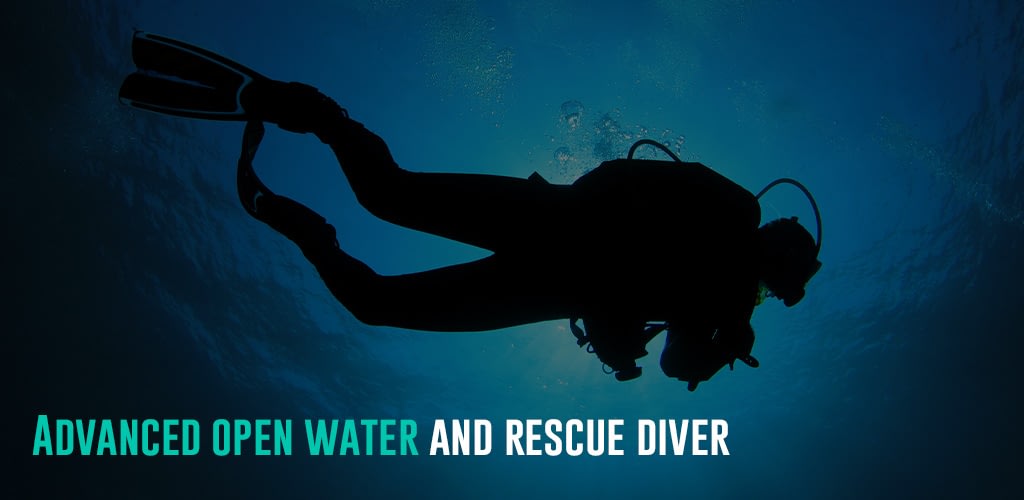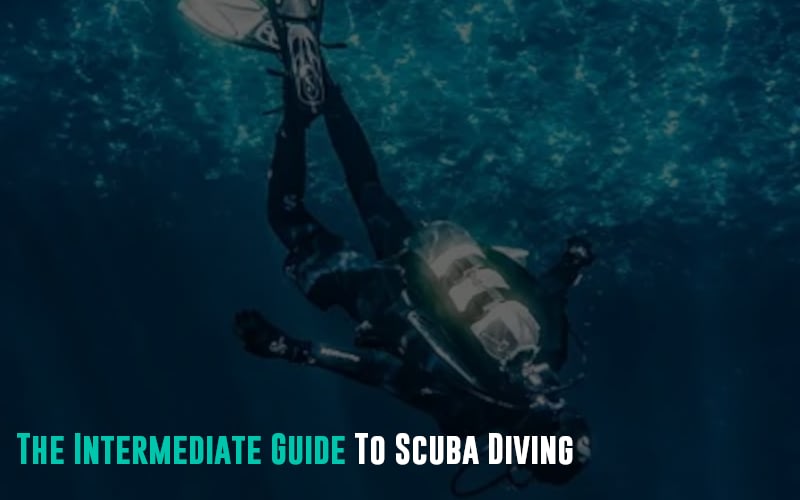Welcome back to the intermediate guide to scuba diving! This is a follow-up to our beginner’s guide here. As beginners in scuba diving, our goals are to build comfort in the water and gear, practice our emergency preparation skills, and get a lot of experience with beginner-level diving! Before practicing intermediate skills, you should be comfortable and ready to handle emergencies. We are looking to advance our skills and explore more of the unknown. This intermediate guide to scuba diving is where the fun begins!
Advanced open water and rescue diver

I can’t strongly recommend doing your Advanced Open Water course. It is less about getting certified and more about a paid tutor crash course where a professional will work with you, observe you, and help fine-tune more advanced scuba diving skills. I recommend finding a very experienced dive instructor for this, too, as you will get more out of the experience. This course is an excellent primer to intermediate diving, as you will focus on the more refined skills that will prepare you for safety, fun, and success.
Further, while not required, the rescue diver course is super valuable. First aid is precious in my activities, especially for mitigating risks and emergencies. The rescue diver course focuses on first aid, handling panicked divers, and being ready to handle emergencies if they arise. Having this skill set may save your life or someone else’s. I can’t recommend enough that if you enjoy scuba diving, take the rescue diver course to be ready and comfortable for handling the unknown.
Fine-tune your buoyancy

Buoyancy is a skill you will need lots of practice to get right. Through all the years I have practiced, I have a system that works for me that allows me to maintain buoyancy well and current. Generally, when diving into the water, I will drop to my maximum planned depth for the dive before touching my buoyancy control device. I keep it empty. Once I hit my bottom depth, I add two quick puffs of air and stop kicking to keep still.
I need some point of reference (or dive computer) to see my depth, and I balance out to neutral buoyancy or even a slight negative. Done! Once I hit neutral buoyancy, I rarely touch it again. As I ascend back to the surface, I dump the air. By the way, make sure you are comfortable and know where your two emergency air dump valves are on your BCD. Practice using them, as they are the quickest way to get the air out. The valve pointing to the surface is the one you want to use.
Focus on natural buoyancy control
The goal is to not fiddle with that thing and focus on using the air in your lungs. You want to “sip” the air into your lungs and have an excellent midpoint of air in your lungs that achieves neutral buoyancy. As you breathe in and out, your buoyancy quickly shifts from positive to neutral to negative and back up smoothly. You want to breathe slowly and calmly and keep your breathing consistent. This consistency is what you want to focus and practice on, as it is where your buoyancy will improve the most. You can control your movement up and down by holding your breath for brief periods. NOTE: by holding your breath, I do not recommend holding a full breath, as the air in your lungs expands as you move toward the surface. This should be a slow and controlled movement and not a full breath.
If your heart rate elevates from either complex current kicking or increased heart rate from fear, it will become harder to control your buoyancy. At times like this, you quickly realize you are working too hard and must calm your heart rate. Slow it down. Take a rest. Scuba diving should be lazy and not a workout. You want a slow heart rate. Focus on breathing and practice hard enough; you will eventually find your body to automate this process more and become instinctive.
Getting comfortable with current
Current is where intermediate scuba diving begins. Current can add a lot of stress—powerful and unpredictable current. You must prioritize staying close to your dive buddy and ensuring you don’t get swept away from the dive site. Current can be upward, downward, and in any other direction. It can be giant pushes or small rivers in the water that you can navigate out of. When caught in a current, brace yourself on a rock and observe your surroundings. Often, you can see other fish, corals, or signs of where the current is going. Sometimes, not too far away, you can see fish swimming calmly and having a good time. Move there. Sometimes, you see fish bracing behind water features to seek shelter. You can use these as well.
Sometimes, the current is only strong and at specific depths. Going up or down can sometimes get you out of the strong current. Before your dive, you can often put your head into the water and observe the coral and fish behavior before you begin the dive, which helps indicate the strength of the current.
Know your limits. If the current feels out of control and you feel in danger, it is better to begin aborting the dive immediately with your dive buddy.
Practicing deep dives

Deep dives have become much more common in intermediate and advanced diving. You will find yourself exploring more of the profound limits of recreational diving. Observing much less light penetrates down the deeper you go is enjoyable. Everything looks more blue and dark. Sometimes, you will need flashlights to be your light source. These are specialty flashlights pressurized for scuba diving.
The important aspect of deep diving is knowing the safety limits of the air in your tank. Exceeding those limits can lead to poisoning, nitrogen air bubbles, and death. Therefore, you may need to stage or carry multiple tanks for intense dives at different depths. This is considered “tech diving” outside recreational diving boundaries. Further, deeper diving will take you into “deco,” which increases the risk of nitrogen bubbles forming in the blood (which can cause “the bends” or decompression sickness. When approaching deco in recreational diving, you should see the countdown timer on your dive computer. To keep out of deco, slowly ascend to keep out of deco.
Decompression
Should you go into deco, it is not the end of the world. You will see the HUD on your watch change and get much more confusing. The critical thing to watch out for is an extra safety stop. You will stay there until the countdown clears when you reach a specific depth, allowing nitrogen to shed naturally. The watch will indicate the depth in which you must do this additional safety stop. Failing to do so puts you at higher risk of decompression sickness, and your watch will recommend you stop diving for quite some time. In addition, it will lock you out. Don’t let this catch you off guard. It could put your life at risk or, at the least, ruin your trip.
When diving deep, begin ascending back to the surface with more than enough air in the tank. In case something goes wrong, you want a buffer.
Getting comfortable with sharks

Sharks are often a fear point for many beginner scuba divers. Some experienced divers will claim they are harmless. I won’t hold the punches and say sharks are harmless. Sharks are predators that have been around a lot longer than human beings. They are naturally evolved for efficiency and hunting in the water. That said, most sharks have particular diets and are very lazy. They generally don’t want to work for their food. When they see scuba divers, they are intimidated. We look like aliens to them. They might be curious but generally not quick to attack unless you make some critical mistakes. Many divers dive with sharks a year with very few incidents overall. Generally, it is safe to swim with sharks. Do not forget they are predators, though.
Above all, the sharks may be sizing you up, seeing if you are food. Sharks might want to “feel” your electrical field. They have a sixth sense that allows them to feel the electricity. To do this, they must come close to you, within 6 feet. Thus, they might do a “fly by” to feel this. If your heart rate is spiking, this might excite them.
Sharks naturally do not hunt humans
Sharks feed and attack old and dying fish because of their efficiency. They are very lazy hunters and may only get desperate due to overfishing and desperation for food. When respected and you present yourself as a poor food source, sharks will respect your dominance in the water. Giant sharks like tigers, great whites, and bull sharks can be a bit more aggressive, but often, they are looking for big prey and don’t stick around like other sharks. It is only briefly when you see them, as they are often on the move. The same rules apply: keep them in sight, get close to other divers nearby, and present yourself as a non-opportunity to the shark.
Further, some sharks might be territorial and not see you as food but as a threat to their territory. When this occurs, they generally start showing warning signs to you. Including quick movements, charging you and then pulling away, and some level of agitation in their interactions with you. Further, they may close a second eyelid over their eyes, which means they are preparing to bite. If you find yourself in such a circumstance, your best defense will be to push or punch up just underneath their nose. This is their sensory for sensing electricity and will shock the shark. Again, this is a terrible position to be in and something to be avoided at all costs.
Sharks are an essential part of the ecosystem. They are fierce and majestic in the water. I’ve experienced them on so many dives that you will miss many excellent dive sites if you cannot find yourself comfortable with sharks. Sharks should not be feared but respected as the fantastic predators they are. Respect them, and they will respect you.
Practicing your air efficiency

Having better breathing practice for improving your buoyancy is a great start. From there, practice makes perfect. You must be conscious of your bottom time and focus on controlling your heart rate and breathing rhythm. Slow and controlled breathing will allow you longer bottom times and get the most out of your tank. Of course, you are also limited by your dive buddies’ air consumption. Once you find a good group with excellent control over their air consumption, you can usually have some grand adventures ranging into a 1-2 hour range on a single tank. In conclusion, improving your air consumption has fantastic synergy with buoyancy control and is integral to maximizing your enjoyment and diving experience.
Don’t wait; plan your next scuba diving adventure today!

